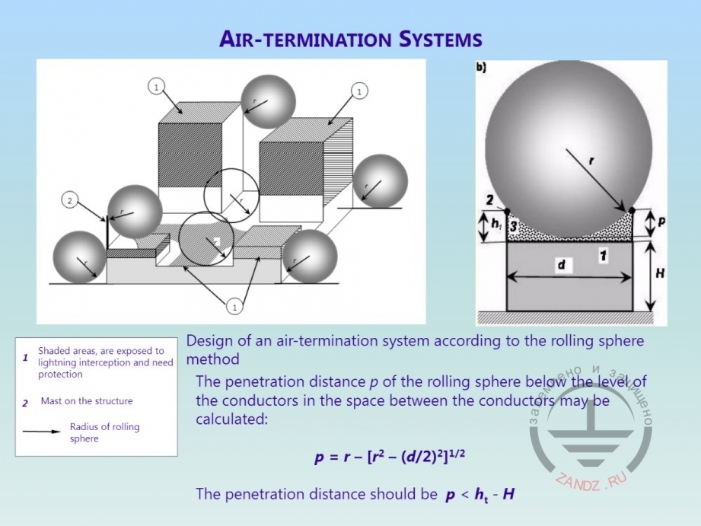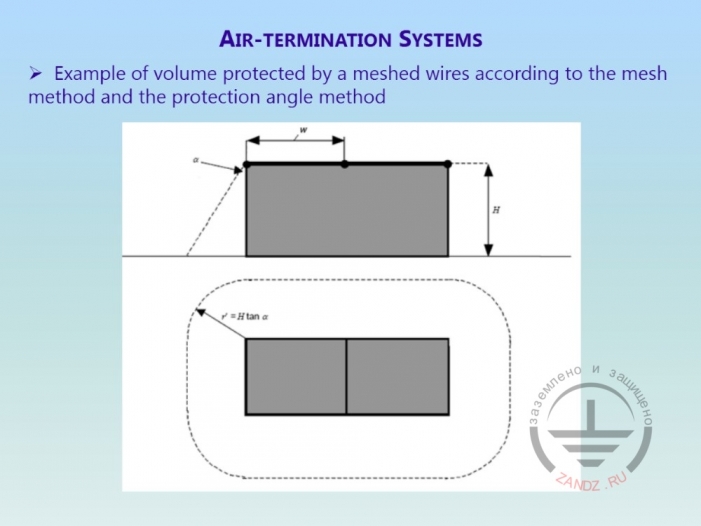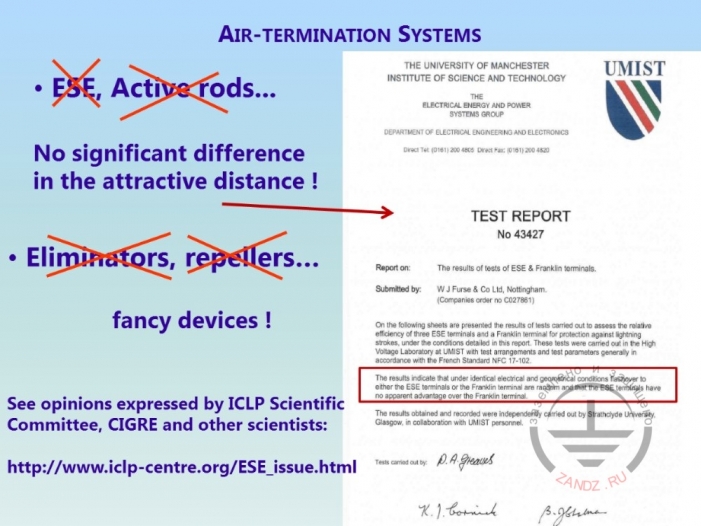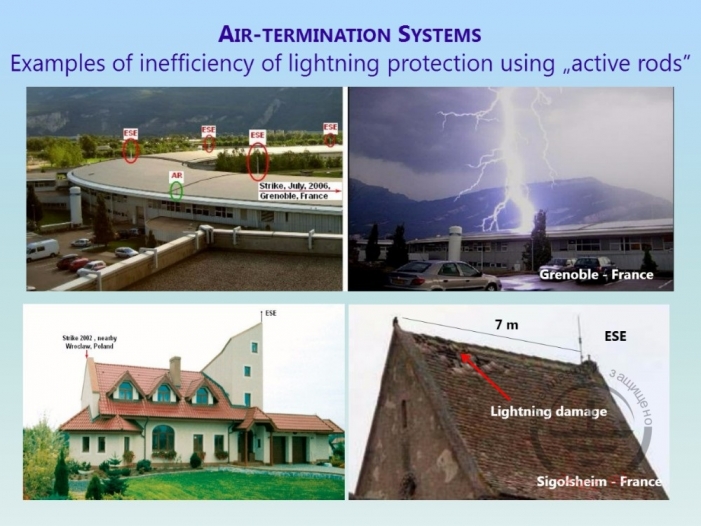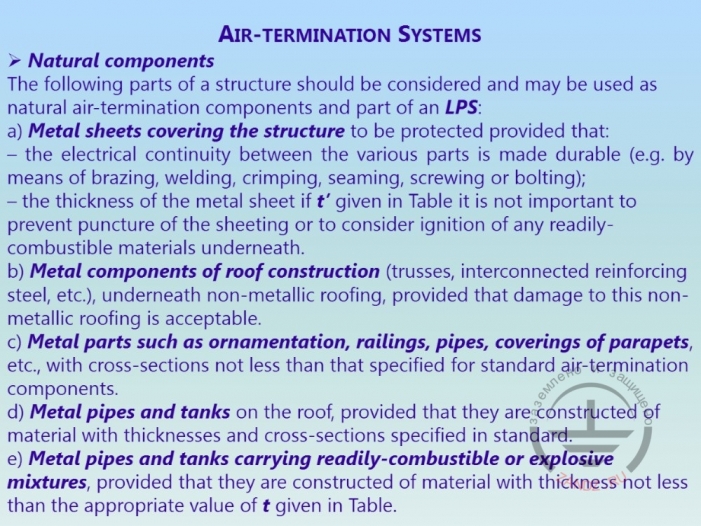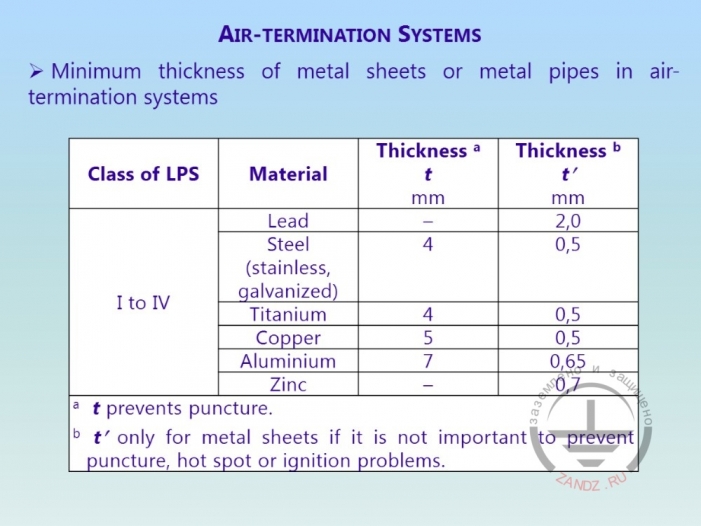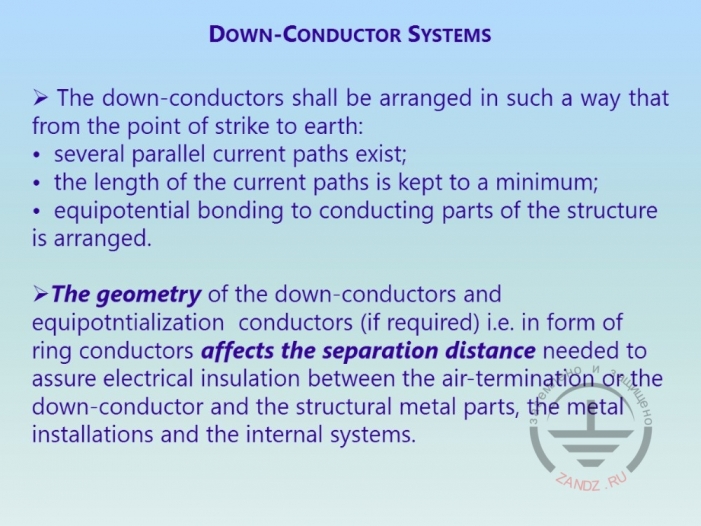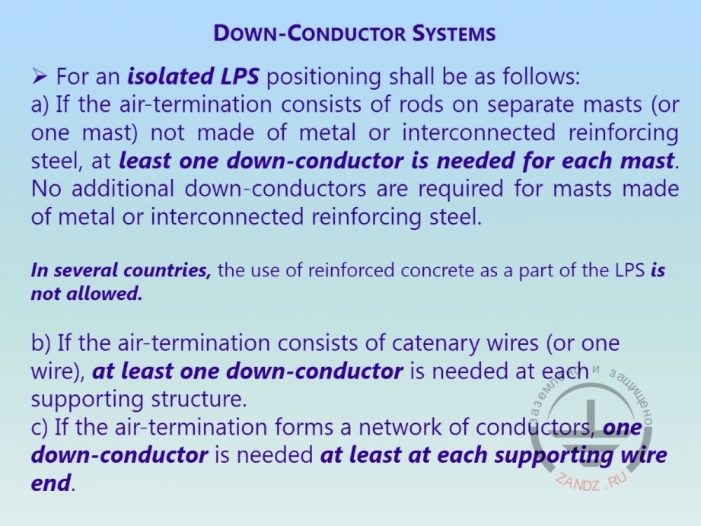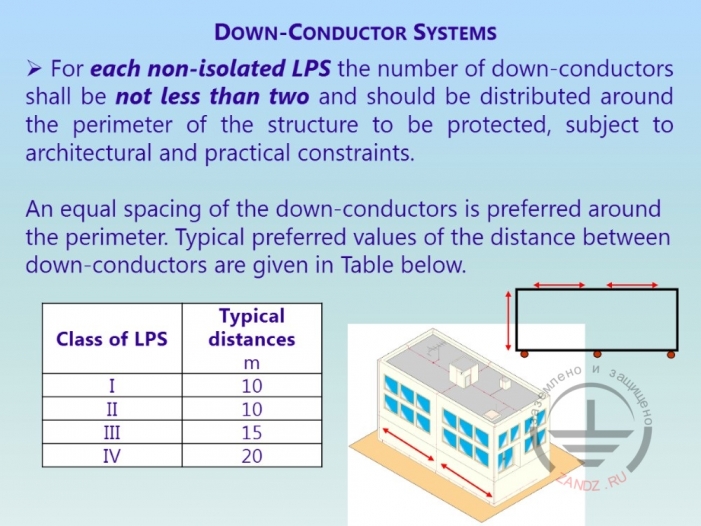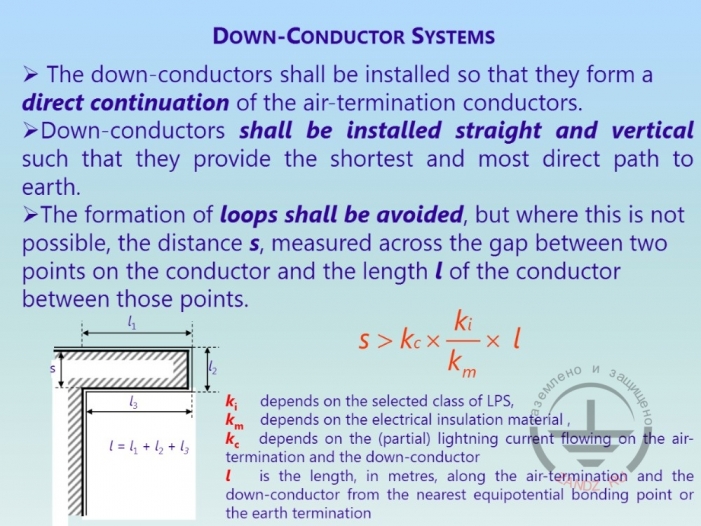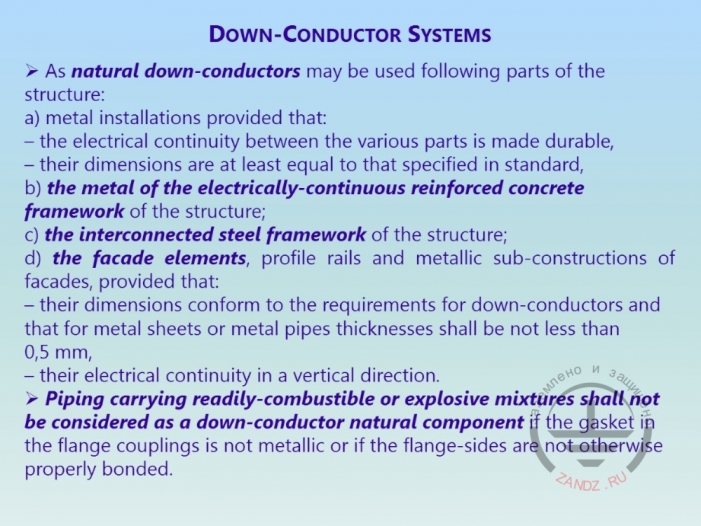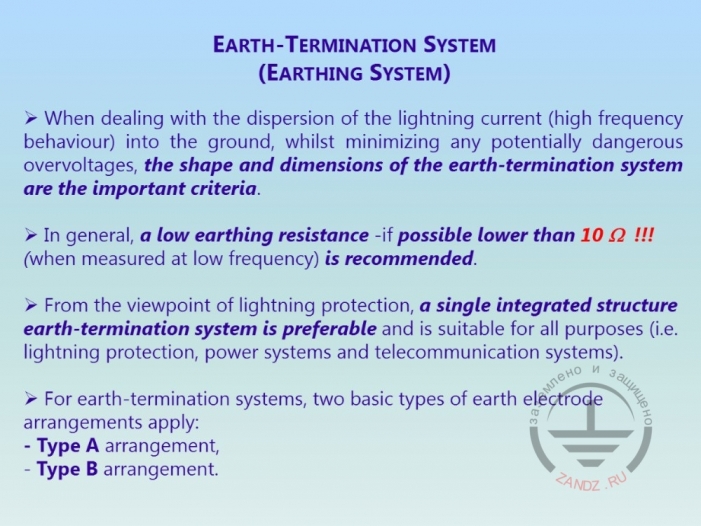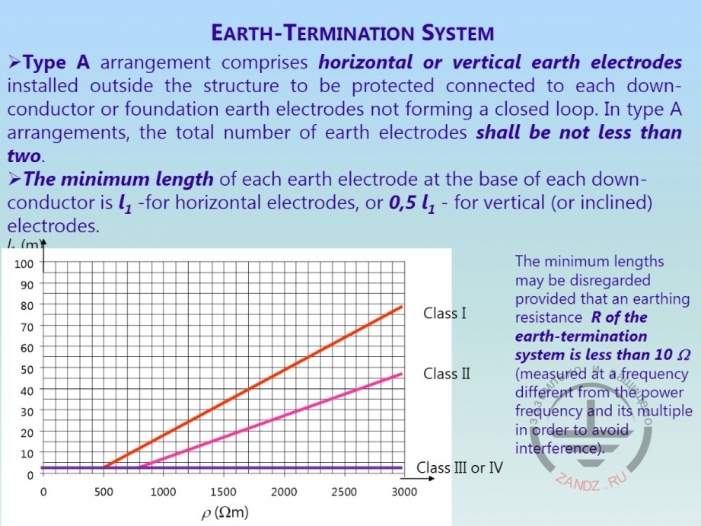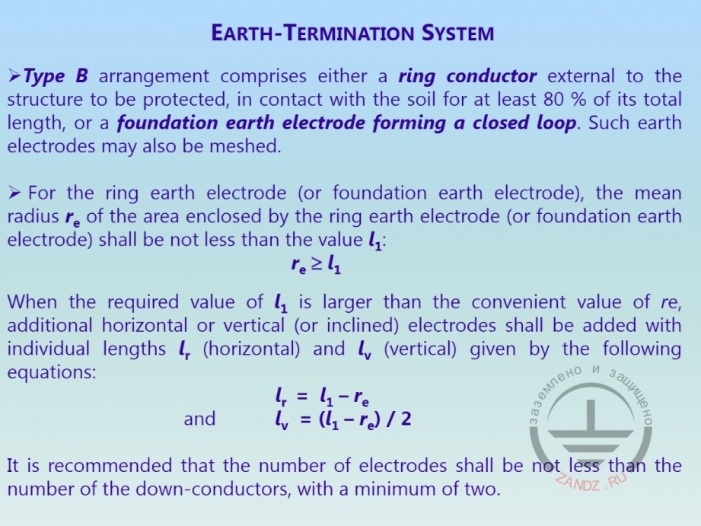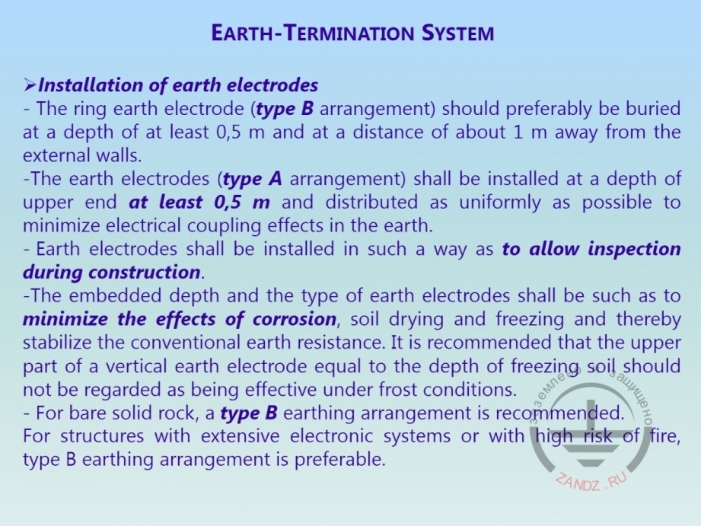The third webinar of a series "Grounding and lightning protection: IEC 62305 standard"
Webinar text. Page 2
Quick navigation through slides:
1. International electro technical standard IEC 62305 Part 3
2. Configuration of IEC standards
3. Main standard series
4. Risk calculation
5. Classification of lightning protection systems (LPS)
6. Diagram of the process of lightning protection design
7. Design of lightning protection systems LPS
8. Description of lightning rod system
9. Image of the possible lightning protection system
10. Geometric model of rolling sphere radius
11. Chart of protection zone dependence
12. Dependence of rolling sphere radius on the building’s height
13. Data chart of various protection methods
14. Example of conical-shaped protection
15. Parameters of protection zone
Page 2:
16. Examples of rolling sphere use
17. Example of mesh method use
18. Funny devices used in different countries
19. Classification and result of lightning strikes
20. Types of natural lightning rods
21. Table of sizes for natural lightning rods
22. Lightning rod geometry
23. Insulated lightning protection system
24. Non-insulated lightning protection systems
25. Calculation of distance between lightning rods
26. Grounding of lightning protection system
27. Types of electronic devices
28. A type of electronic device
29. B type of electronic device
30. Installation of ground electrodes
31. Table of materials for lightning protection
32. Internal lightning protection systems
33. Equipotential bonding systems
34. Grounding system scheme
35. Example of a system with a dead-earthed neutral
36. Example of circular grounding network
37. Calculation formula of a safe zone
38. Table of Ki coefficient values
39. Table of Kc coefficient values
40. Detailed calculation of Kc coefficients
41. Image of lightning current distribution
42. Touch voltage
43. Step voltage
44. Lightning protection systems maintenance
45. Table of lightning protection maintenance
46. Questions and answers
Example of using rolling sphere
— The hardest thing for the design and designers is to estimate the volume to be protected using rolling sphere radius. Here the designers use CD program. With its help they can define sizes necessary to protect this or that building. On the image you see the use of rolling sphere for one or several buildings. The buildings which are dashed - these are surface areas, subject to lightning disturbances and have to be protected. They are under the direct strike, under the direct risk of a lightning strike and the distance between the buildings can be counted in accordance with the protection level, it is calculated for each building individually. And the arrangement of lightning rod systems should be considered for each case individually.
Example of mesh method use
— Here we see an example of a spatial volume which is under protection in accordance with the mesh method and protection angle method.
Funny devices, used in different countries
— Now we are making a pause for questions, but in the end of this part I'd like to tell you that there are such funny devices, used in many countries, in Brazil, for example, or Great Britain. I am showing you examples, which I took from the report of a British University. And you can read in this report that there is significant difference in effective distance between lightning protection systems.
Classification and result of lightning strikes
— Let's continue our communication in the format of questions, please. If you want to ask or tell something on lightning protection, lighting rod systems, please write your questions in the chat in Russian, I will answer in Russian too. I, of course, can speak Russian, but for me it takes more time, Anastasia will interpret for you. I can see the first question. I'd like to being with the first question.
— "Why there is no mutual influence of lightning rods, that is protection zone of a double lightning rod is equal to the total of two single lightning rod protection zones?". Certainly, it is an important problem. We need to think about the efficiency of installing lightning rods in different places. I am very sorry, but we don't have a lot of time to discuss this big topic, but we can come back to the example I showed on this image. On this picture you see, if we change the minimal distance between two separate lightning rods, there will be overlapping of volumes. This means that in certain parts, some parts, some elements of the building will be overprotected. You need to consider that. I think you should study each individual case separately. I am not sure I can talk about this problem for a long time now, but if you are interested in something, you can send me an email without any problem. You can write in Russian. Write your questions in Russian, I understand, but I will answer you in English with great pleasure.
— Let's move on to the second question. "Is lightning protection grounding resistance normalized?". Yes, of course, it is. We will talk about it in a few minutes in the next part of the report.
— "Is it correct to consider that it is better to define a protection zone with the method of a protective angle much smaller, than the rolling sphere radius because of a possible error?". Well, it's a good question. This method is applied to small objects. It is not restricted by the minimal sizes of a lightning rod. We have a minimal radius. And of course, we need to view the minimal protection angle. But a direct lightning strike directly depends on the object sizes. And then, if the building is very small, we need to analyse the financial issues. It means there a need to protect such a small object from a direct lightning strike or not. If there is electronic equipment inside, then, of course it is necessary to use internal lightning protection systems.
—"Does the object influence a protection zone, for example, in Russia, lightning protection standard for the Ministry of Defence establishes the dependence of the protection zone on the square of the protected object?".
— Hello, Zhenya! This is my friend from the Ukraine. He is greeting me and asks a question. We met at some conference. He is a very good specialist. And the question is: «Can we protected people outside the buildings with the help of lightning protection systems or only inside?". Well, it's a good question, Eugenie. Of course, we can minimize direct lightning strike into a human being, who is within an immediate vicinity to the building or lightning protection system. But if the human is outside the building, outside the lightning protection zone, then of course the effect is reducing. We can be under a threat. It's an influence of electromagnetic field. And of course we can be subject to danger from step and touch voltage, being in these zones. There happened such situations, for example, in Poland, when a man was using a wired telephone and was sitting near some metal board and the building was hit by lightning. And the relation between the wire of this man and the lightning protection system worked out and he was hit by lightning. It's a big problem. We can minimize the possibility, the probability of a direct lightning strike, but we cannot minimize different effects of lightning strikes, which can affect health of human or living beings. Or, for example, if a man has some metal devices, like cardio stimulators or something like that, they are more subject to a lightning strike risk.
— Next question. Sorry, there is a big question about Bazelyan's work. We know that the publications of different scientists, which are intended to support other methods and lightning protection system standards. They exist and there are large discussions between different groups of scientists. There is even a forum for such discussions. I had a chance to talk to professor Bazelyan in Novosibirsk at the conference. And my question was. In fact I can't answer your question now, but if you want to apply that and come to a consensus on these standards, of course you need to discuss these methods with their representatives directly at the meetings of such committees or their representatives. We talked with professor Bazelyan and held some meetings at the conferences. And there are conferences, that in fact advertise using of such devices, but they are not introduced into IEC standards. There is a problem in the European committee on standardization. Some of my colleagues, they want to create new systems of standards, which are mainly based on the lightning protection sizes. But this is a big topic for discussion; today the disagreements between the scientists on this matter are great. There are various methods of lightning protection and everything is discussed at the conferences and group discussions.
— Vasiliy Kuryanov is asking where he could find a video recording. Alexey already answered where the webinar recordings are published.
— And the last question, I'd like to answer is from Dmitry Valkovich. "Is protection zone increasing at the height larger than the rolling sphere radius?".
— And the final thing, I see that Alexey wrote information about recording of the webinars. If you have any questions on them, send them to Alexey.
— I hope I have answered all questions. If you don't mind, we will continue our presentation. I forgot about very beautiful pictures. By the way, it refers to the question of professor Bazelyan. I showed you three examples of objects here. One of them is located in France, in Grenoble, where lightning rods were used. On the second picture, we see an image which was shot occasionally during a lightning strike. There were such examples in Poland at a private residence of one Warsaw citizen. The lightning hit the roof corner. You see it is marked with a red arrow. The length of the roof is about 7 meters and you see the use of a lightning rod was not effective in this case. There was also an example of a small chapel. There was a lightning rod on it and the lightning stroke the distance, about 6 meters from this chapel. In fact, there are much more registered pictures, which explain the efficiency, adequacy and determination of lightning protection sizes, it is very important.
Types of natural lightning rods
— And the last part of lightning rod system, I nearly forgot it. It includes natural components. They can be used as a part of natural components of lightning rods and lightning protection parts. Here you see five categories of natural components - metal slabs, covering the buildings, metal roof components, also metal parts, such as ornamentation, railings, pipes, parapet coatings, handholds. But their cross section should not be less, than the sizes indicated in lightning rod standards. Also the use of metal pipes, roof reservoirs.
Chart of sizes for natural lightning rods
— This table contains sizes and thicknesses of metal slabs and pipes, which will be used as parts of natural components in lightning protection systems. Different thicknesses must be used for different materials and different types of metal. These are minimal thicknesses, they are applied when it is important to prevent puncture in metal slabs and pipes. Later we will talk about systems of lightning rods. Before doing so, however, I would like to say that IEC 62305 system widely covers the questions given in the third part.
Geometry of a lightning rod
— We shall now talk about lightning rod system. They should be arranged the way, so there were some parallel current lines, more than two, from a lightning strike to the ground. And the length of current lines should be minimal. Usually when the current approaches the ground, the voltage drops. That is why, the conductive components should minimize current strength, and potential equalization to the current conducting parts of the building should be organized. For high buildings, structures higher than 20 meters, it is very important. Geometry of a lightning rod is very important. It should form itself a circular conductor which will influence on the separation distance, required for the provision of electric insulation between lightning rods or down conductors and metal parts of the structure. It is also important to remember the distance at which they wil be located. We cannot estimate potential equalization directly.
Insulated lightning protection system
— If we have an insulated lightning protection system, then lightning rods will consist of lightning arresters on separate masts. There should be at least one mast. It means, every lightning rod must be grounded. There is also a possibility to create natural ground conductors and connected them by the grounding system. The use of reinforcing concrete is normal in Europe, but I have no information about Russia. If lightning protection system is inside the building. Sorry, if it is divided, is free-standing. That means it is the use of a free-standing mast. There should be at least one lightning rod. If we have a network of lightning rods, then there should be one lightning rod at each end of this network.
Non-insulated lightning protection systems
— If we use non-insulated lightning protection systems, that is, if we install lightning rods directly on the building, there should be at least two of them. In these cases, the distance between the free-standing lightning rods refers to the class of lightning protection system and varies from 10 to 20 meters. For large buildings, the distance should be corresponding; everything depends on a certain case.
Calculation of distance between lightning rods
— I talked about separating distance. This means that there is a possibility that lightning rods may form themselves loops. But in fact, we need to avoid such a formation of loops. We need to pay more attention to the separation distance between lightning rods. We need to consider the height, sorry, length of conductor and three coefficients. Coefficients Ki, Km and Kc. They are given in the chart, you see, they depend on the lightning protection class, materials and lightning current, which goes through the lightning rod. How current is distributed, when we use lightning rods system. And of course, natural lightning rods, they can be used as the part of lightning protection system. But they should be, they should present themselves electrical continuity between different parts. They should be connected and their sizes, should at least be equal to the values declared in the standards. There are four types of materials. If we use reinforced concrete structures, then of course electrical continuity should exist here.
Lightning protection system grounding
— In this part, the next one, we will see grounding systems, for what the system of lightning rods is used. When lightning strikes and hits a lightning rod, it is necessary to understand, that ground resistance should be less than 10 A. We can change this value and design lightning rod system, considering the number of electrodes. But the value of the resistance should not be very high. Yes, Ohm, sorry.
Types of electronic devices
— It is preferable to use free-standing integrated grounding systems. It fits all purposes: lightning protection systems, power plants, supply systems, telecommunications. Thus, in some countries the designers should know that different types are used for different purposes. But sometimes, I don't want to discuss, but some designers define the parameters incorrectly.
A type of electronic device
— A type of electronic device includes horizontal and vertical ground electrodes. They are connected to each lightning rod or ground electrode, but they should not form a closed loop. The minimal length may be not taken into account, but it should be not less than 10 Ohm. This chart shows the values, which depend on the protection level class. We see class I, class II, class II, class IV and the length of horizontal electrodes depending on the class of lightning protection level. We are also discussing such problems how to achieve maximal efficiency of each electrode. It is problematic. If power is too high, then the efficiency, it means, that for horizontal electrodes 0,5 - it means, that the minimal length of horizontal electrodes should be twice higher, than vertical. It is well known, that vertical electrodes are inefficient in some cases.
B type of electronic device
— B type of electronic device includes circular conductors, which form themselves a closed loop. In such cases we cannot fail to say about the minimal length. We are comparing the radius of surface which covers these electrodes here. It is easily calculated, depending on the square to be protected and length of ground electrodes. If you see an equation, where re is higher than l1, then we need additional horizontal and vertical electrodes. They should be added, for example, horizontal - it is Lr, value r and vertical Lv.
Installation of ground electrodes
— Now we come to an important question, which refers to the installation of ground electrodes. The depth on which they should be lying should be not less than half a meter. And a circular electrode must be plunged to the distance not less than 1 meter from the building. The top part of the electrode must be plunged to not less than 0,5 meters. For example in Novosibirsk you have special conditions, because the top part of such electrodes it freezes due to soil freezing, that is why, everything depends on the atmosphere, climate, weather conditions. And of course, it is necessary to study the corrosion effect so the life and operation of electrodes was prolonged. If technical conditions are good, then electrodes can operate for more than 20 years. Of course everything depends on the design and use of electrodes. But for hard ground, we need to use B type installation and elements which are artificial. So, we minimize the influence of chemicals, some substances which are contained in the ground on the metal used for electrodes.
<< Previous Page
slides from 1 to 15
Next Page >>
slides 31 to 46
Useful materials for designers:
- Webinars with the leading industry experts
- Everything for the calculation of grounding and lightning protection
- Useful materials: articles, recommendations, examples
Related Articles:


 6. How to do that?
6. How to do that?


